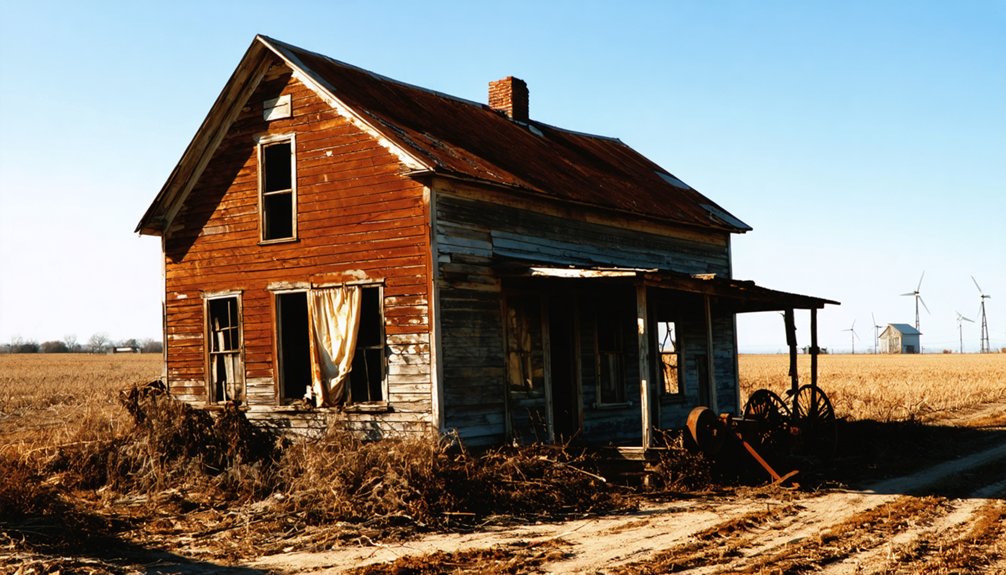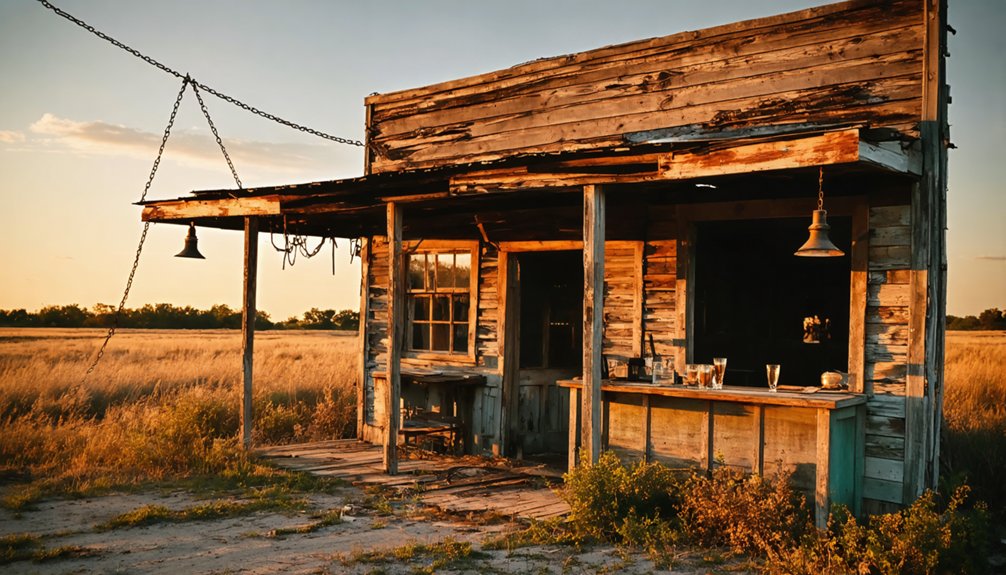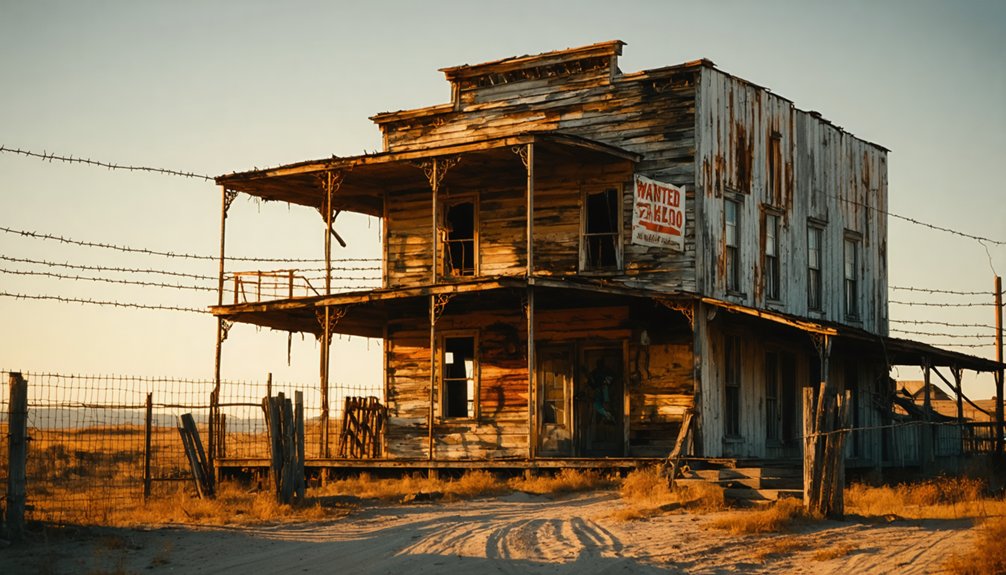Texas ghost towns reveal boom-and-bust cycles that shaped the state’s history. You’ll find over 900 abandoned settlements, from Wilson County’s 31 documented ghost communities to once-thriving oil towns like Thurber. These places fell victim to specific forces: railroad reroutings, resource depletion, Dust Bowl devastation, and demographic shifts. While many rural counties continue losing population today, grassroots preservation efforts fight to maintain these historical remnants. The silent streets hold stories waiting to be uncovered.
Key Takeaways
- Wilson County holds the title of “ghost town capital of Texas” with 31 documented abandoned communities.
- Railroad reroutings directly caused the decline of once-thriving towns like Helena, Belle Plain, and St. Mary’s of Aransas.
- Resource depletion transformed boomtowns like Thurber from prosperous mining communities into abandoned landscapes.
- The 1930s Dust Bowl devastated Central Texas farming communities, forcing 2.5 million rural Texans to migrate elsewhere.
- Community-driven preservation efforts since 1962 have maintained historical structures through events like Victorian tea parties and ghost tours.
The Rise and Fall of Frontier Communities

The rise of Texas ghost towns fundamentally emerged from the complex and often turbulent process of frontier settlement that followed Texas’s independence in 1836. You’d find these communities sprouting rapidly as Texas’s population surged from 20,000 in 1830 to 140,000 by the late 1840s, driven by generous land grants offering substantial acreage.
Despite their initial promise, frontier challenges proved insurmountable for many settlements. Military outposts like Fort Graham provided temporary security, but conflicts with Native Americans—particularly Comanches and Apaches—created persistent instability. The decision to move the capital from Houston to Austin under Mirabeau B. Lamar’s leadership further shaped settlement patterns across the republic. Many early settlers constructed dogtrot cabins with central breezeways to combat the harsh Texas climate.
Community resilience varied dramatically; while some frontier towns evolved from military outposts into thriving centers, others couldn’t sustain themselves when economic conditions shifted or military protection withdrew. The settlements that couldn’t adapt ultimately transformed into the abandoned remnants you’ll discover scattered across Texas today.
Wilson County: Texas’s Ghost Town Capital
While many Texas counties boast abandoned settlements, Wilson County stands unrivaled as the state’s ghost town capital with an extraordinary count of thirty-one documented abandoned communities.
Located southeast of San Antonio, this historically rich area saw numerous settlements develop along the Old Gonzales Road during the 19th century.
Wilson County’s landscape, dotted with ghost towns, tells the story of 19th century ambitions along the historic Old Gonzales Road.
Towns like Saspamco, Marcelina, Nockenut, and Pandora fell victim to economic shifts, railroad reroutings, and highway bypasses. Some communities like Union Valley, settled before the Civil War, dwindled to mere handfuls of residents.
Today, these abandoned places drive ghost town tourism as visitors explore historical structures preserved by local organizations.
The concentration of these sites gives Wilson County unique historical significance, preserving tangible connections to Texas’s frontier past and settlement patterns. Unlike Indianola which became a barren site submerged under Matagorda Bay, many Wilson County ghost towns still have visible remains.
Texas leads the nation with 511 ghost towns scattered across its vast landscape, each telling a story of boom and bust cycles.
When the Railroad Bypasses: Stories of Abandonment

Throughout Texas’s developmental history, railroad routes determined the fate of countless communities, with some flourishing alongside steel tracks while others withered into obscurity.
When you explore towns like Helena in Karnes County, you’ll discover how railroad rerouting effects transformed prosperous centers into virtual ghost towns. A single decision to create “The Big Curve” bypassing Helena redirected destiny itself. This once-thriving community, which served as the county seat until its decline, demonstrates how transportation changes can devastate local economies.
Similarly, Belle Plain lost its county seat status after the Texas and Pacific Railway established Baird six miles north, while St. Mary’s of Aransas watched its prominence evaporate when rail lines chose Rockport instead. Texas currently has 511 ghost towns, more than any other state in America, largely due to these transportation-related abandonments.
These economic downturn narratives reveal a common pattern: railroad bypasses triggered cascading losses—county seats, businesses, and population.
Towns like Toyah, once vibrant railroad hubs, now stand as hollow reminders of how transportation infrastructure decisions could either nurture communities or condemn them to obsolescence.
From Boom to Bust: Oil and Mining Town Lifecycles
You’ll find the most dramatic narratives of Texas ghost towns in places where oil and mining once fueled explosive growth, only to leave behind abandoned structures when resources depleted.
Thurber exemplifies this cycle, transforming from a coal-mining powerhouse with 10,000 residents into a near-empty landscape after petroleum replaced coal as the preferred locomotive fuel.
The discovery of oil in Ranger similarly created a temporary metropolis of 30,000 people, complete with 800 active wells by 1920, before economic shifts rendered these boomtowns obsolete relics of resource extraction’s impermanence.
Breckenridge experienced a similar fate when oil was discovered just a year after Ranger’s boom, causing the population to explode from 1,500 to 30,000 eager workers.
These abandoned towns now serve as historical testimonies to the volatile nature of resource-based economies that dominated Texas in the 19th and early 20th centuries.
Black Gold, Empty Streets
Countless Texas towns experienced dramatic lifecycles of prosperity and abandonment during the late 19th and early 20th centuries as extractive industries transformed the state’s economic landscape.
You’ll find Thurber’s story particularly telling—once Texas’s premier coal producer with 10,000 residents, it collapsed when black gold was discovered near Ranger in 1917. The town was famous for its production of “black diamonds” that fueled Texas industry before oil took over. Its iconic old smokestack still stands as a stark reminder of its industrial past.
These company-owned settlements exercised near-total control over residents’ lives, providing amenities like electricity and opera houses while simultaneously restricting freedoms.
When locomotives switched from coal to oil, economic devastation followed. Labor unrest and strikes marked their final years as populations dwindled.
Today, you can walk these empty streets where boom towns like Terlingua and Shafter stand frozen in time—ghostly reminders to the volatile nature of extraction-based economies that once promised endless prosperity.
Wildcatters’ Forgotten Legacy
The wildcatting phenomenon represents one of the most dramatic chapters in Texas’s industrial history, where risk-taking prospectors transformed barren landscapes into bustling communities almost overnight.
When you explore former boomtowns like Ranger or Thurber, you’re witnessing the remnants of wildcatters’ impact on rural Texas. These settlements exploded from hundreds to tens of thousands of residents within months as oil gushers promised prosperity.
Company-built infrastructure—housing, stores, and entertainment venues—created distinct boomtown cultures where diverse ethnic groups worked side by side.
Yet this prosperity proved ephemeral. As wells depleted, often within just years of discovery, these towns faced rapid decline.
Labor strikes, resource exhaustion, and technological shifts ultimately transformed these once-vibrant communities into the haunting ghost towns you can visit today.
Dust Bowl’s Legacy: Agricultural Community Collapse

When you travel through central Texas today, you’ll encounter the skeletal remains of farming communities that collapsed when the Dust Bowl stripped away up to 75% of viable topsoil in the 1930s.
Families abandoned homesteads en masse as agricultural productivity plummeted, with over 34 percent of Texas Panhandle farmers surrendering their land between 1935 and 1937 alone.
The exodus transformed once-thriving agricultural centers into ghost towns as desperate residents migrated toward urban centers or followed Route 66 westward, leaving behind empty schoolhouses, abandoned general stores, and wind-scoured foundations as evidence of environmental catastrophe.
Topsoil Loss Impact
As devastating dust storms swept across the southern plains during the 1930s, they carried away more than just particles of earth—they stripped entire communities of their agricultural foundation and economic viability.
The catastrophic topsoil erosion created an agricultural sustainability crisis of unprecedented scale:
- Over 850 million tons of topsoil vanished in 1935 alone—nearly 8 tons per American.
- Farmland values plummeted 28% in high-erosion counties.
- 34% of Texas Panhandle farmers abandoned their land between 1935-1937.
- Soil depths decreased by up to 3 feet in a single growing season.
You’re witnessing the aftermath of this environmental collapse today in Texas’s ghost towns—communities that simply couldn’t survive when their fertile foundation literally blew away, leaving barren, unproductive land that could no longer sustain the economic and social fabric of rural life.
Failed Farming Communities
Devastated by unsustainable agricultural practices and relentless drought conditions, once-thriving farming settlements across the Texas Panhandle collapsed into the ghost towns you’ll find scattered throughout the region today.
These communities disintegrated as nearly 750,000 family farms disappeared nationwide between 1930-1935, with over 34% of Texas Panhandle farmers abandoning their land by 1937.
You’re witnessing the aftermath of economic despair that forced half a million Americans into homelessness.
Failed harvests, mortgage foreclosures, and plummeting crop prices created a mass exodus that permanently altered the landscape.
What remains—abandoned homesteads, derelict fences, and dead orchards—stands as testimony to agricultural hubris.
Despite government conservation districts established in 1935 and restoration efforts like Rita Blanca Grasslands, many communities never recovered, their empty structures silent monuments to environmental catastrophe.
Exodus to Cities
The mass exodus from rural Texas during the Dust Bowl era represents one of America’s most significant demographic shifts, with approximately 2.5 million people abandoning their agricultural communities throughout the 1930s.
This urban migration fundamentally transformed both the places they left and the destinations they sought.
The demographic shifts manifested in four distinct patterns:
- Route 66 became the primary westward corridor, carrying desperate families in packed “jalopies”.
- California’s San Joaquin Valley received over 86,000 migrants in just one year.
- Rural counties continued losing population even after the Dust Bowl ended.
- Birth rates declined in agricultural areas, compounding the demographic collapse.
You’re witnessing the legacy of this exodus in Texas’s 500+ ghost towns—stark monuments to freedom of movement born from environmental and economic catastrophe.
Hidden Histories: Exploring Texas’s Most Fascinating Ghost Towns

Throughout the rugged landscape of Texas lie scattered remnants of once-thriving communities that illuminate the state’s complex past.
You’ll discover Terlingua, where mercury miners once toiled, now transformed into a quirky tourist haven. Nearby, Shafter’s crumbling silver mills stand as silent witnesses to boom-and-bust economics.
Venture to Indianola’s submerged ruins where ghostly legends persist of Civil War treasures hidden beneath Gulf waters.
Stand at Indianola’s shore, where storms drowned a city but couldn’t silence whispers of Confederate gold beneath the waves.
The company town of Thurber reveals how coal fueled Texas’s industrialization before markets shifted.
Meanwhile, Helena maintains a determined presence with 200 residents preserving its hidden treasures through active historical conservation.
These forgotten settlements offer you unfiltered glimpses into authentic Texas—places where free spirits thrived, industries boomed, and nature ultimately reclaimed what humans abandoned.
Why Texas Leads the Nation in Abandoned Settlements
While many states boast abandoned settlements, Texas distinctively leads the nation with over 511 completely deserted ghost towns and 558 documented sites of historical abandonment. This unprecedented level of rural decline stems from complex geographical and economic patterns unique to the Lone Star State.
Four primary factors drive Texas’s exceptional abandonment patterns:
- Severe population distribution imbalance – growth concentrated in the Dallas-Austin-Houston triangle while 75 counties lost residents in 2022-2023
- Cascading economic collapse – when foundational industries depart, multiple businesses follow in rapid succession
- Critical infrastructure deficiencies – communities lacking healthcare, education, and essential services can’t sustain themselves
- Real estate market deterioration – inventory ballooning to 6+ months with price declines of 15-30% in affected areas
Modern Threats: Counties Facing Population Decline Today

As Texas’s ghost town phenomenon continues to develop, we now observe a concerning contemporary pattern of population decline across numerous counties.
You’re witnessing history repeat itself in real time, with 75 counties losing residents between 2022-2023, primarily in rural areas.
The crisis is most acute in High Plains and West Texas, where counties like Loving (-25.37%) and King (-19.48%) face existential demographic collapse.
Rural West Texas counties face population freefall, with Loving and King losing over 19% of residents in a single year.
This exodus stems from limited economic opportunities, natural population decrease, aging demographics, and infrastructure deficits.
Without robust rural revitalization strategies, some counties could lose 40-70% of their population by 2060.
Economic resilience initiatives remain vital as shrinking tax bases cripple public services and reduce political representation.
The state’s future hangs in balance between concentrated metropolitan growth and the potential emergence of dozens of new ghost towns.
Preservation Efforts: Saving Texas’s Vanishing Heritage
Texas’s vanishing heritage stands at a critical crossroads, with preservation efforts representing the last line of defense against permanent historical erasure. The Texas Historical Commission, alongside 200+ county commissions, orchestrates systematic protection of these cultural landmarks while promoting heritage tourism.
Community engagement manifests through innovative approaches:
- Local preservation groups, like Helena’s 1962 initiative, maintain abandoned structures through grassroots action.
- Fundraising events including Victorian tea parties, ghost tours, and 10K races finance restoration projects.
- Artistic revitalization, exemplified by Terlingua and Lobo’s transformation into cultural havens.
- Educational programs providing technical assistance for cemetery preservation and historic property care.
Despite challenges of unclear property titles, infrastructure deficiencies, and strict preservation regulations, dedicated Texans continue reclaiming their distinctive historical narrative through collective determination.
Frequently Asked Questions
Can You Legally Explore or Live in Texas Ghost Towns?
You can’t legally explore ghost towns without permission due to property ownership restrictions. For habitation, you’d need to acquire legal title and navigate zoning regulations, infrastructure challenges, and preservation requirements.
What Paranormal Activity Is Reported in Texas’s Abandoned Towns?
You’ll encounter ghostly sightings, eerie whispers, and EVP recordings in Texas’s abandoned towns. Places like Helena document apparitions, unexplained footprints, self-moving furniture, phantom sounds, and peculiar cold spots throughout these desolate locations.
Which Ghost Towns Have Underwater Ruins Due to Dam Construction?
You’ll find rich submerged history beneath Lakes Buchanan (Old Bluffton), Texoma (Preston, Hagerman, Cedar Mills, Woodville), and Belton (Sparta, Bland)—all sacrificed to dam construction, awaiting underwater exploration during drought periods.
How Accurate Are Ghost Town Locations on Modern GPS Systems?
With 511+ ghost towns across Texas alone, you’ll find modern GPS accuracy considerably limited. Historical mapping inconsistencies mean locations often represent county-level precision rather than exact coordinates where towns actually stood.
What Items Are Commonly Found by Metal Detectorists in Ghost Towns?
In your treasure hunting pursuits, you’ll unearth coins, buttons, ammunition remnants, household debris, commercial tokens, and industrial artifacts—each historical artifact revealing the complex social tapestry of abandoned communities.
References
- https://en.wikipedia.org/wiki/List_of_ghost_towns_in_Texas
- https://www.caller.com/story/news/local/2018/10/25/texas-state-most-historic-ghost-towns-america/1755702002/
- https://www.texastribune.org/2024/11/14/texas-population-changes-rural-urban/
- https://www.geotab.com/ghost-towns/
- https://www.county.org/county-magazine-articles/summer-2025/ghost-towns
- https://www.texasstandard.org/stories/today-on-texas-standard-december-4-2024/
- https://mix931fm.com/texas-ghost-towns-history/
- https://texashistory.unt.edu/explore/collections/TGTN/
- https://www.texasbeyondhistory.net/forts/36-44.html
- https://www.thestoryoftexas.com/discover/campfire-stories/frontier-folk



